Chapter 8: Altruism (helping others)
1/48
Earn XP
Description and Tags
+ Lecture content from March 4th & 7th
Name | Mastery | Learn | Test | Matching | Spaced |
|---|
No study sessions yet.
49 Terms
Why do we help?
Social exchange → we help those who have helped us
Social norms dictate helping in some situations
To aid our survival → helping kin and those who may help us makes it more likely for us to pass on our genes
Under what circumstances will we help?
When there are few bystanders
When we observe someone else helping
When we are not in a hurry
When the person needing help is similar to us
Who is most likely to help?
People high in emotionality, empathy, and self-efficacy
Men in risky situations BUT women in less risky situations
*Overall men and women do not differ in helpfulness
How can we increase helping?
Reducing ambiguity and increasing responsibility
Evoking feelings of guilt
Socializing prosocial behaviour
Altruism
A motivational state
Goal = increase another’s welfare without conscious regard for one’s own self-interests
*NO alterior motives → you just want to help and be kind
Opposite of selfishness
Social-exchange theory
Human interactions = transactions that aim to maximize one’s rewards and minimize one’s costs
Rewards can be internal (makes you feel good) or external ($$$)
Weakness of the social-exchange theory
Circular explanations → “How did you know that there are internal rewards?”
*Egoism → self-interest motivates ALL behaviour
Egoism
A motive (supposedly underlying all behaviour) to increase your own welfare
The opposite of altruism (which aims to increase someone else’s welfare)
T or F: We are more likely to redeem ourselves with helpful behaviour when other people know about our misdeed
TRUE → related to guilt
Helpful deeds neutralize bad feelings
Feel bad-do good
T or F: Happy people are helpful people
TRUE
What are 2 social norms that motivate prosocial behaviour?
Reciprocity norm
Social-responsibility norm
Reciprocity norm
The expectation that people will help those who have helped them (not hurt them)
We “invest” in others and expect dividends in return
Social-responsibility norm
The expectation that people will help those who depend upon them → it is their responsibility
People should help those who need help (without regard to future exchange)
How does gender affect receiving help?
Women = offered help equally to men and women
*Men = offered more help to women
Rooted in the sexist belief that women are less competent and they depend on strong men
What are 4 evolution psychology factors that affect helping?
Kin selection
Direct reciprocity
Indirect reciprocity
Group selection
Kin selection
Evolutionary-based theory
We show favouritism towards those who share our genes (e.g., family)
Selected altruism towards relatives → motivated to help make our mutually shared genes survive
T of F: According to kin selection, parents will generally be more devoted to their children than their children are to them
TRUE
What are the 3 main altruism theories? (explaining why we help)
Social norms
Social exchange
Eviolutionaty
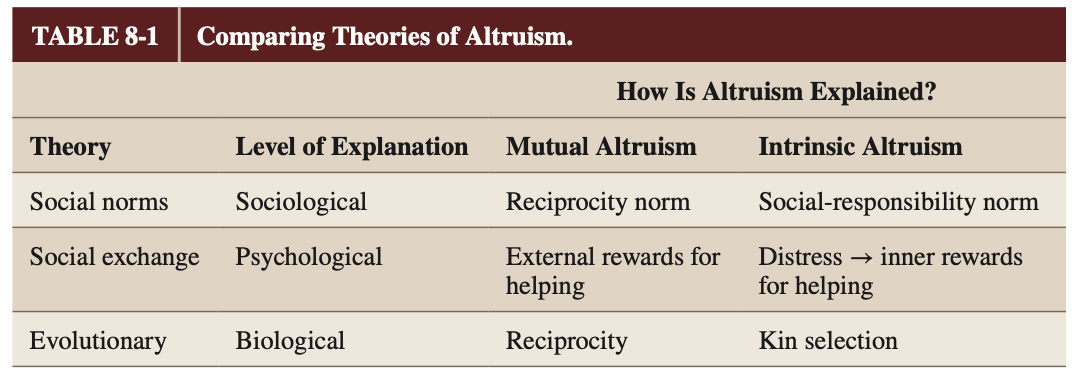
Empathy
Vicarious experience of someone else’s feelings
Putting yourself in someone else’s shoes
Happens when we feel attached to someone OR when people we identify with
How does the presence of bystanders influence helping?
The presence of other bystanders can greatly decrease helping interventions
If we see that other people are not helping = we are also likely not to help
*Bystander effect
How do we interpret whether to help in situations?
*Informational influence → we look at what others are doing to help interpret whether or not we should help
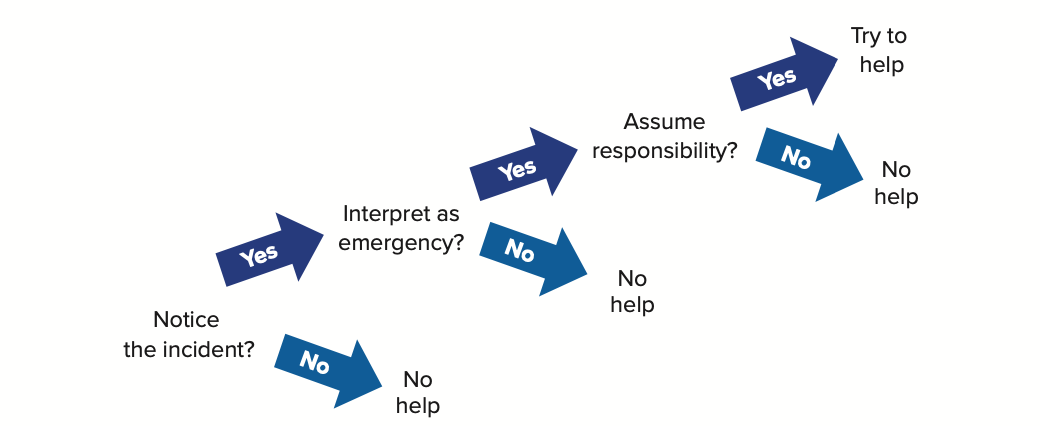
Bystander effect
A person is less likely to provide help when there are other bystanders
T or F: Prosocial models do NOT promote prosocial behaviour
FALSE
“Prosocial models promote prosocial behaviour!” → we are more likely to help when someone else does
How does similarity affect helping?
We are more likely to help people who are similar to us
Similarity → Liking → Helping
How does gender affect helping in risky situations?
Men = more likely to help in risky situations
Women = less likely in risky situations
*Overall men and women do not differ in helpfulness
Moral inclusion
Regarding others as within your circle of moral concern
Viewing people who differ from you as being within your human circle → your moral values and rules of justice apply to them
*Equality
Moral exclusion
Perceiving certain individuals or groups as being outside the boundary within which you apply moral values and rules of fairness
*Inequality
Diagram of how we can increase helping

Genuine altruism
Increasing another’s welfare when there is zero benefit to the self
What are some self-focused (selfish) theories that explain why we help?
Kin selection
Signalling
reciprocity
Mood
Are we more likely to help relatives or non-relatives?
Relatives → *kin selection theory
Difference becomes even more pronounced in life-or death situations
Signalling theory
Evolution-based theory
Public behaviours = signals to others of our fitness and resources
Signals = costly → provides further evidence of fitness
Signalling and doorholding experiment
Confederates displayed an emotional state (high or low) and followed people into a building
Findings = people were more likely to hold campus doors open for people who were happy (high in emotional resources)
People were more likely to push the door for people who were neutral/sad (lower in emotional resources)
Direct vs. indirect reciprocity
Direct reciprocity = immediate, one-to-one exchanges of favours
"I scratch your back, you scratch mine."
Indirect reciprocity = helping others, even if they don't repay you right away
“What goes around comes around”
Prisoner’s Dilemma
Shows the tendency for people to pursue their own self-interest EVEN THOUGH it leads to a suboptimal outcome for both parties . . .
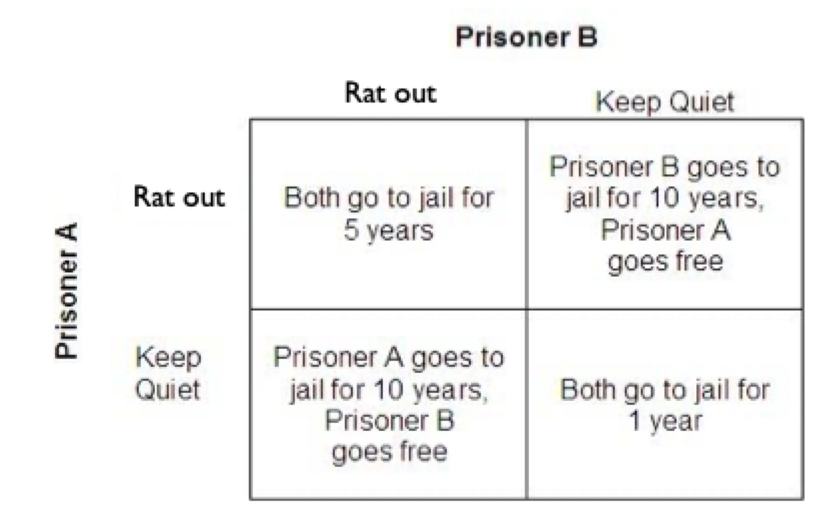
Warm glow (mood affects helping)
Helping makes you feel good
Moral high ground
Negative state relief (mood affects helping)
If you feel bad = you want to feel good → THUS you relieve bad feelings by helping
Positive state maintenance (mood affects helping)
If you feel good = you want to maintain the good feelings → THUS you help
Other-focused altruism
We help others to increase their welfare
*Even when benefit to self is not apparent or considered
Empathic concern
Other-oriented emotion (tenderness, sympathy, compassion) that drives us to reduce another person’s distress
*Even when there is no benefit to the self
What are 2 examples of how we help others for selfless reasons?
Other-focused altruism
Empathic concern
Egotism vs. altruism experiment (will you help Carol Mercy)
Would people help out a student (Carol) who was in need to school help?
Results:
People with high empathy & who were told to adopt Carol’s POV = equally likely to help Carol REGARDLESS of whether they saw her in class
*Genuine/other-focused altruism
People with low empathy & who were told NOT to adopt Carol’s POV = more likely to help Carol when they saw her in class
*Worried about future guilt…
T or F: Apes have empathetic concern
TRUE
5 stage model of bystander apathy
There are 5 obstacles to overcome before you help in a bystander situation
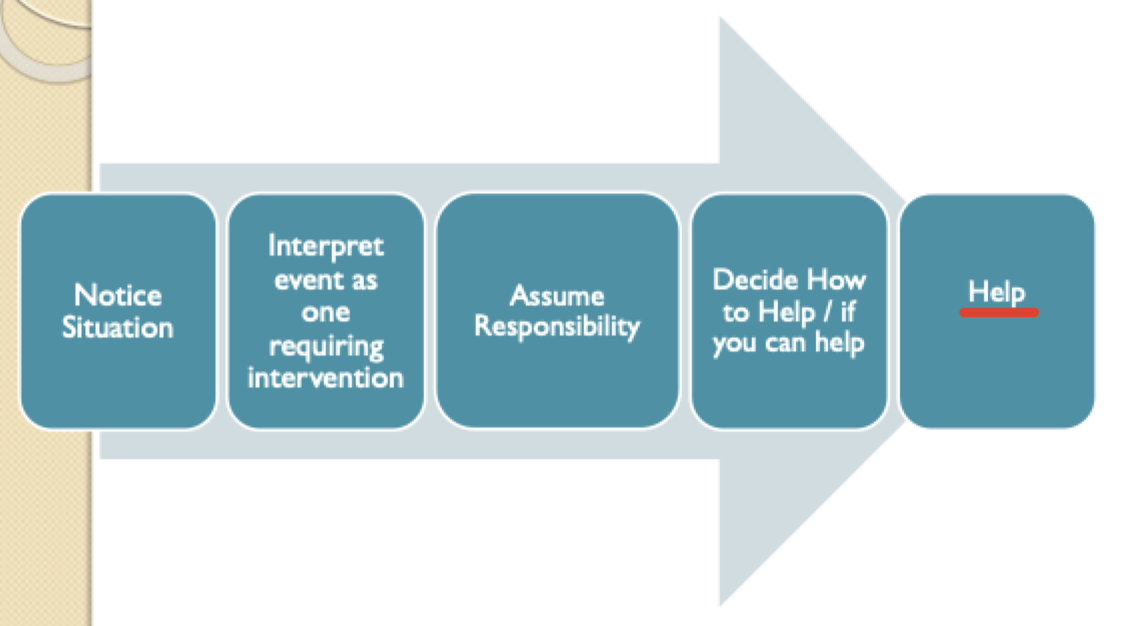
The “Good Samaritan” experiment (noticing the situation)
Seminary students were assigned to different conditions:
Talk topic = (1) Good Samaritan vs. (2) job opportunities
Arrival status = (1) On time vs. (2) Late
Situation = on the way to the talk building they pass a confederate slumped and moaning in the doorway → do they help?
Results:
When on-time = more likely to help
When talk topic is about good samaritan = more likely to help
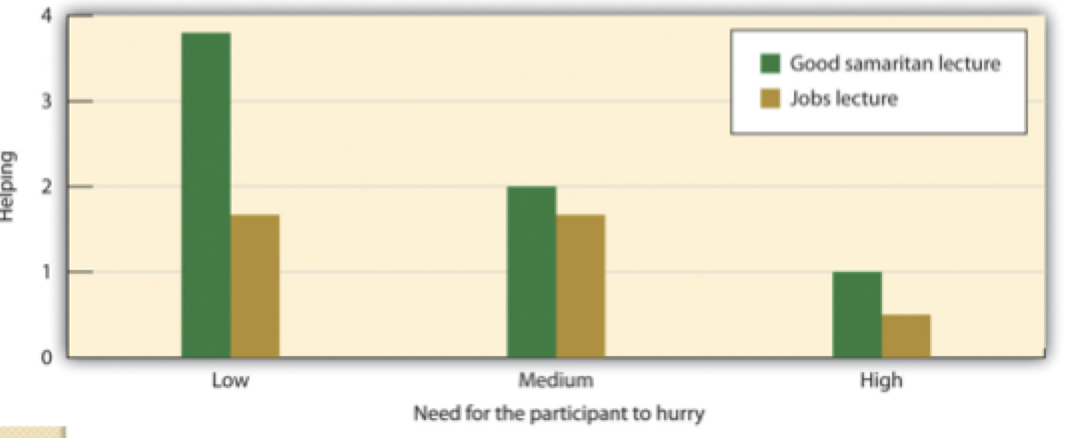
Interpretation fighting experiment
Situation = participants witnessed one of two staged fight between a man and a woman:
Fight 1 = “Get away from me, I don’t know you!”
Fight 2 = “Get away from me, I don’t know why I married you!”
Results = people were more likely to help during the 1st fight → because they interrupted the couple as being strangers
Pluralistic ignorance
Situations where a majority of group members privately reject a norm
BUT they (incorrectly) assume that most others accept it
Diffusion of responsibility
Tendency for each group member to diffuse personal responsibility for acting by spreading it among all other group members
Smoke-filled room experiment
Situation = participants are complete a survey when smoke begins to fill the room
Participants are either:
Alone
With 2 confederates → *they did not react to the smoke
Results = participants were more likely to notify the experimenter when they were alone
*Demonstrates diffusion of responsibility